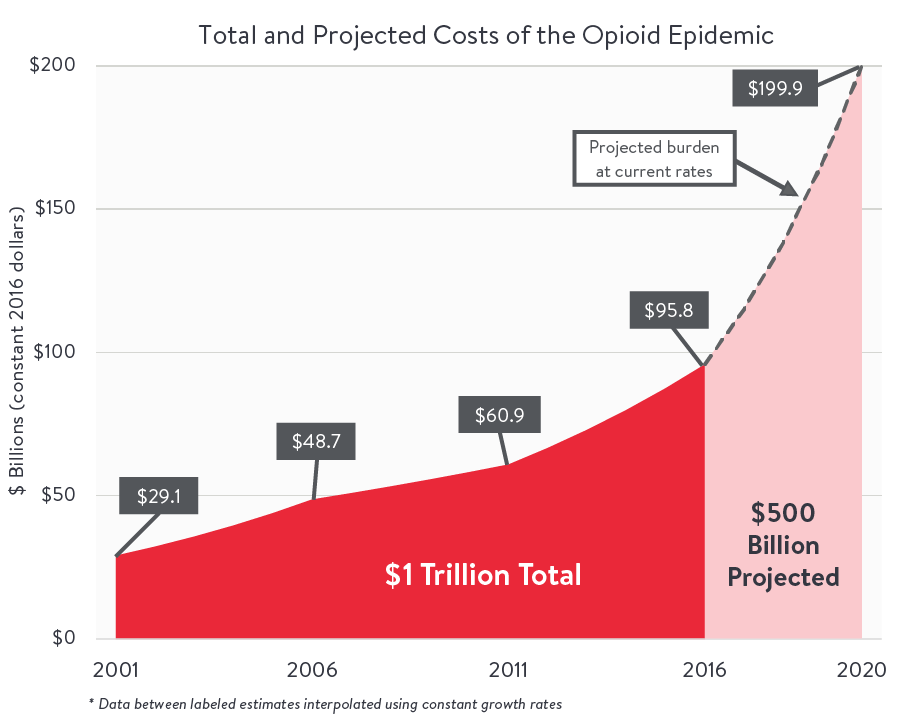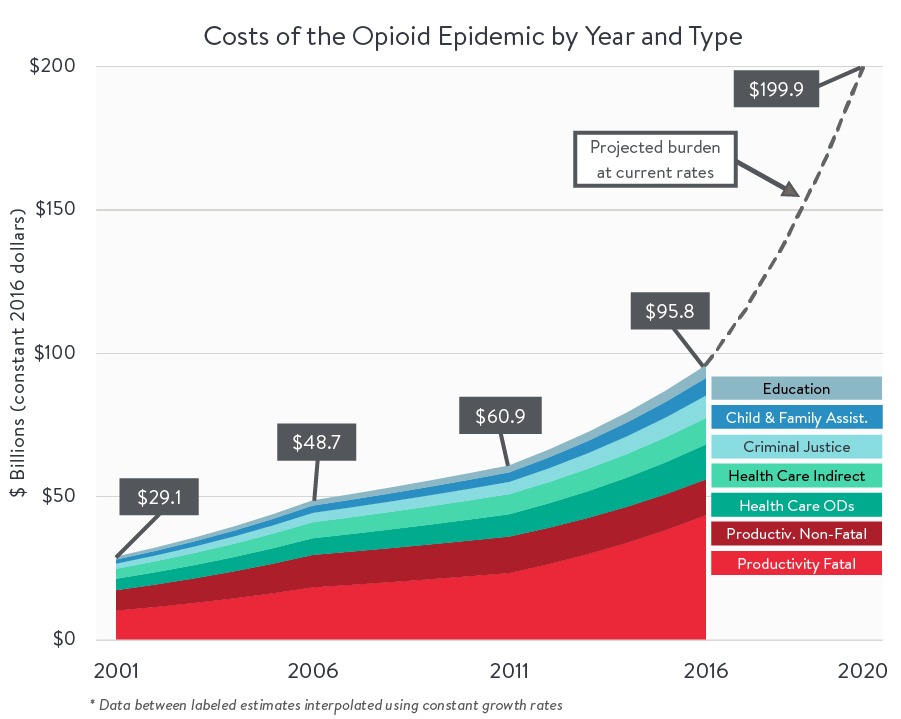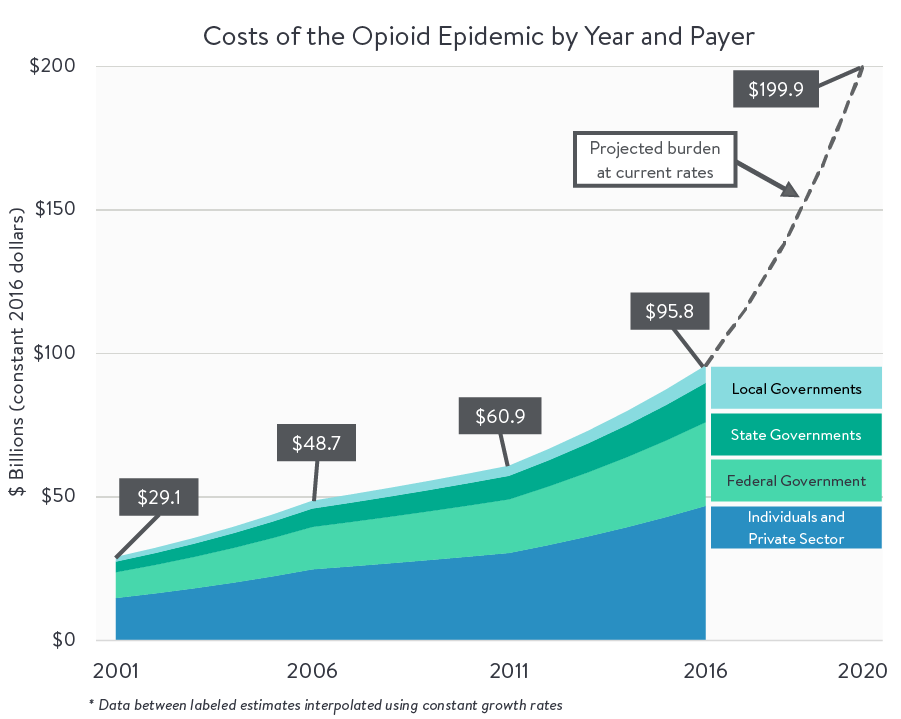Economic Toll of Opioid Crisis in U.S. Exceeded $1 Trillion Since 2001
February 13, 2018
Washington, DC — The cost of the country’s opioid crisis is estimated to have exceeded $1 trillion from 2001 to 2017, and is projected to cost an additional $500 billion by 2020, according to analysis released by Altarum, a nonprofit health research and consulting institute.
The annual cost of the opioid crisis increased from $29.1 billion in 2001 to an estimated $115 billion in 2017 (all cost estimates are shown in 2016 dollars). The growth rate between 2011 and 2016 was double the rate observed between the previous 5 years, and is projected to increase again in 2017. Based on these data, Altarum estimates the cost of opioid misuse, substance use disorders, and premature mortality to exceed $500 billion over the next 3 years if concerted and sustained action to address the crisis is not taken and current use and mortality rates persist.
Who is Bearing the Cost?
The costs of the opioid crisis are borne by individuals in the form of lost wages; the private sector in lost productivity and health care costs; and federal, state and local governments in lost tax revenue and additional spending on health care, social services, education and criminal justice.
The greatest cost comes from lost earnings and productivity from overdose deaths—estimated at $800,000 per person based on an average age of 41 among overdose victims. This figure is largely made up of lost wages of workers and productivity losses of employers, but it also weighs on government in the form of lost tax revenue. It has increased in recent years as the epidemic has transitioned away from older people to younger ones and from prescription opioids to illicit drugs. The number of opioid overdose deaths is estimated to have exceed 62,500 in 2017 based on data through June.*
The Health Care Sector
Health care costs related to the opioid crisis reached $215.7 billion from 2001 to 2017. This stemmed largely from emergency room visits to treat and stabilize patients after an overdose, any associated ambulance and Naloxone use required, and related indirect health care costs associated with the increased risk of other diseases or complications. A disproportionately large share of this cost has been borne by Medicaid in recent years. Since Medicaid expansion in 2014, the number of overdoses connected to uninsured patients has fallen substantially, but the burden to states in additional health care costs has increased.
The Value of Estimating the Burden
A cost estimate is valuable in understanding the scope of the problem, identifying areas of society most affected by it, and creating evidence-based interventions to address the issue. As communities across the nation grapple with how best to respond to the crisis, such estimates can be a critical starting point for action.
This approach was recently applied in Lorain County, Ohio, a suburb west of Cleveland with an opioid overdose rate of 2.5 times the national average, according to 2016 data from the Centers for Disease Control and Prevention (CDC).
Altarum’s analysis of the economic burden of the opioid crisis in Lorain County showed individuals, the private sector, health sector, government, and other institutions within the county had sustained costs of $200 million related to the crisis. The largest cost—$139.8 million—resulted from lost earnings and productivity, revealing a disproportionate burden on individuals, families, and businesses. The analysis also showed that relatively little was spent on treatment and prevention efforts that could curb these substantial losses.
This analysis helped the county, in partnership with the Nord Family Foundation, identify a plan to address the crisis that integrated best practices and customized approaches that account for their strengths as well as gaps in capabilities. Work is now underway with a variety of stakeholders to implement the plan, which includes improving collaboration among community support services, developing a full continuum of services from prevention to recovery supports, instituting an education campaign, updating state policies to remove barriers to action, and creating a system of data collection and coordination.
Beyond the Economic Cost
This analysis is concerned with the economic cost of the opioid crisis, but the human cost—the emotional toll on individuals with a use disorder, and that on their families and communities is substantial and vitally important to any complete analysis of the crisis. We are not able to quantify those additional costs in our analysis due to the inherent difficulty of estimating them.
Policy Recommendations
To address the economic and human toll of the opioid crisis, policymakers should focus on three areas:
- Prevention. Educating clinicians on the appropriate use of opioids and alternatives to treat pain; monitoring opioid prescribing and targeting high prescribers; encouraging benefits managers to explore drug tiers to create higher financial barriers to accessing opioids; and working with insurers to encourage alternatives for managing chronic pain.
- Treatment. Payment and delivery system reform to engage clinicians and community support services to better manage the needs of substance users; and encouraging employers to provide value-based insurance design features to remove barriers to treatment.
- Recovery. In-depth understanding of the length of time to get substance users to recover from the dependency and to facilitate access to the essential local support services that are key to more successful recovery rates.
Methodology
Altarum employed this analysis in part using its Value of Health Tool, which characterizes the financial and health impacts of an investment in prevention from the perspectives of alternative stakeholders. Through this tool and other standard research methods, Altarum estimated the potential economic burden of the opioid epidemic from two categories of impact:
- reductions in direct costs of public and private expenditures to mitigate or respond to opioid-related harms, such as law enforcement costs, and
- recovered economic benefits that were not realized as a result of opioids, such as lost earnings from opioid substance use disorders and related deaths.
*We based our estimate of opioid deaths on Christopher Ruhm’s “Geographic Variation in Opioid and Heroin Involved Drug Poisoning Mortality Rates” from the December 2017 issue of the American Journal of Preventive Medicine.
Research methods are consistent with previously published academic work, costs are estimates in constant 2016 dollars, and all future benefits are discounted at a 3 percent discount rate.
For additional information on methodology and data sources, see our analysis of the economic burden of the opioid crisis in 2016.
Altarum is a nonprofit organization that works with federal and state agencies and foundations to design and implement solutions to improve the health of individuals with fewer financial resources and populations disenfranchised by the health care system. We achieve measurable results by combining our expertise in public health and health care delivery with technology, workforce training and continuing education, applied research, and technical assistance. Our innovative solutions lead to better health for beneficiaries and better value for payers.


